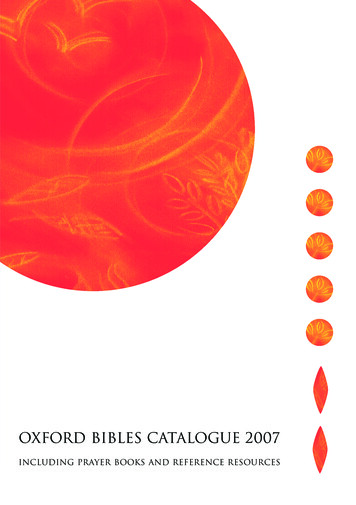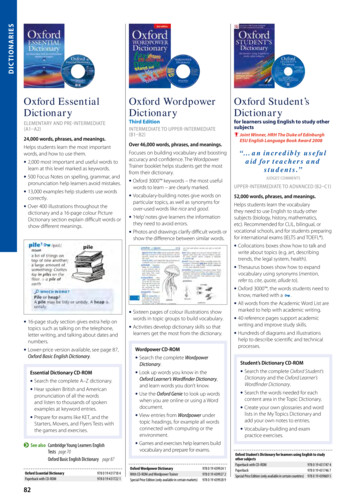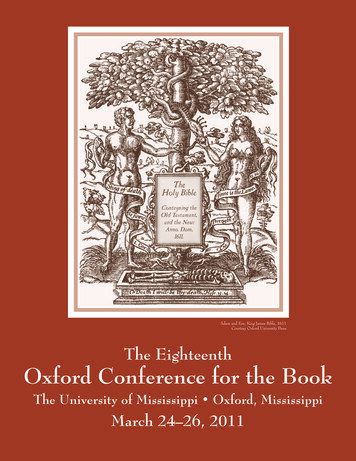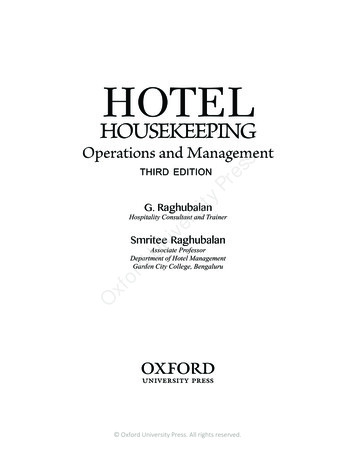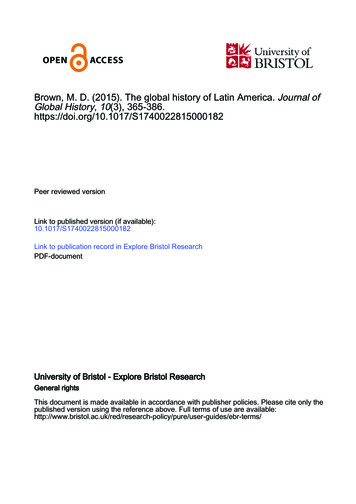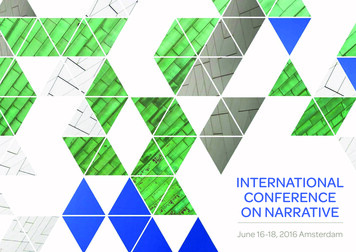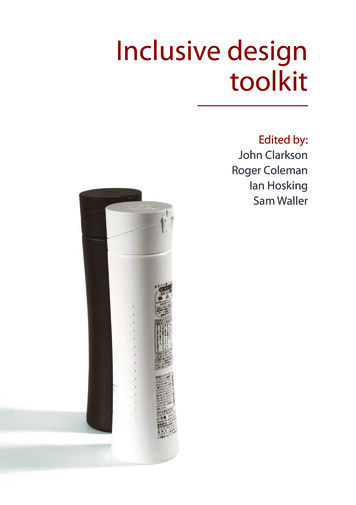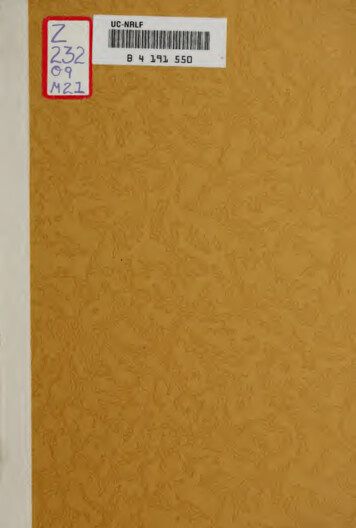
Transcription
NOV1mGIFTTheUniversity PressOxfordTHE SHBl?.l}0 [m Jv 'Tl lfS-l iljKE/.THE EARLIEST UNIVERSITY PRIKTIN«-HOUSE 1669*1468'— 1911
»THEJiI I-Yfi{l§n Y/ Rte 1517
TheUiiiyersity PressOxfordILLUSTRATIONS OI OXE OF THE SEVEN GRANDSPRESS ATI'RIXGAINED HY THETHE BRUSSELS INTERNATIONAL EXHIBITION 1910
THE CLARENDON BUILDING, USEDASTHE PRINTING-HOUSE 1713-1830(From the Oxford Almanack1905)
THEOXFORD UNIVERSITY PRESS'1468'— 1911Abridged from A Brief Account of the University Press,by Falconer Madan. With additionsOXFOED UNI VERSITY PRESS, alone amongTHEablethe Presses of the world,ofproduce atoisall its publications forlist326 years.*aodAfBa(figti« 2) ( mqiiam !jcc feoinbutratMCioms fiipca epfoUix rcgubm confcquantuc a&iicrtimiis beprecpmuc xtnobis et etnmbug cjuj ipc an? imat cence&at ItommuB fibe quam fitrtepimufl cijflol iacupAi.conriiniatocj;pei:tat5B iufliriet»pofitam cc»t»nam; cf fmtetnn mfeceofvxtzxn cfcei:nam»btetat«i?etoa coufiiitone ct obptobno efectio , juirrittcgimtftipnr cnOum hominum nofVcum pet ijiietni CO patti ommpoteti cfi Jpicitu fanctdfllotia rt impetium fn.feoila fcculocuntatttfti.Cpplidt cfpe Uc\ofiinlx lofancti Irwjn'mi niapof olcMum a5 papam lautseitim Irnprcflano mmi AVCeccmbba . ponic» 5t fmita ArtCccc t Ipviij pvij-SieA PAGE FROM THE FIRST BOOK PRINTED AT OXFORDThe first Oxford book known is the Latin Commentary by St. Jerome (really by Rufinus of Aquileia)on the Apostles' Creed, which bears the date 1468 butthis was, probably, an intentional misstatement, and,;as Mr. FalconerMadansays in his Brief Account thegreater the bibliographer thethe true dateis1478.morecertain heIn 1468 onlyand Switzerland possessed theItaly,art of printing.224G32isthatGermany,
THE OXFORP XJNIVEESITY PEESS2The PressatOxfordliashad threelives.period of activity carde to an end inIts first1486-7, andbooks comprise its output.Onenoteworthy as having its colophon in red,sixteendijBferentof theseisaffording the earliest instance of printing in coloursin England;another contains the earliest woodcutin England a third, which is assumedto be a product of the Oxford Press, is Cicero's Oratiopro Milone the first classic printed in England. It isborderknown;supposed that Theodoric Eood, coming from Cologne,printed these books by himself at Oxford.Thelifeof the second Press was brief in the extreme.from 1517 to 1519, and only eight of its publications are known. All, except a broadside, bear thearms of the University, and three are issued cumIt lastedprivilegio,i.e.of the Chancellor.All the provincialpresses of the first half of the sixteenth centuryweresimilarly short-lived.Continuous Activity since 1585The third epoch dates from the year 1585, whenwith 100 lent by the University, Joseph Barnes,bookseller, of Oxford, began printing, and the OxfordPress has been in continuous activity ever since.The movingspirit in initiating this enterprise was theEarl of Leicester, the favourite of Queen Elizabeth.At first the printing was carried on in hired premises.In 1586 appeared the first Greek book, six selectedhomilies of St. Chrysostom, and ten years later Hebrewtype is met with. In 1595 appeared Wermueller'sPerl mewn adfyd, a Welsh translation of an Englishversion of the original German, with the new imprintyn Ehydychen the latter being the Welsh word fora ford of Oxen. Among other books printed by Barnes'*,
CONTINUOUS ACTIVITY SINCEare thefirst15853English edition of the Latin text of Richardde Bury's Philohihlon sive de amove lihrorum (1599) theCatalogue of the Bodleian Library (1605) BrianTwyne's Antiquitatis academiae Oxoniensis Apologia,the earliest history of the University (1608)andCaptain John Smith's Map [and Account] of Virginia issued perhaps at 105. and now worth 125. In theyear 1599 'a tracte containing the artes of curiousPaintinge, Caruinge, and Buildinge written first inItalian by Giovanni Paolo Lomazzo painter of Milanwas printed in an English translation.Archbishop Laud zealously fostered the growing;first;;'Press, obtaining for it various valuable privileges.Inthe years 1621-38 five editions of Burton's immortalAnatomy of Melancholy wereprinted, and in 1640Bacon's Advancement of Learning was produced. In1658 was appointed the first Architypographus orController of the Press an office contemplated in the——Laudian Statutes and, eleven years after, the munificence of Archbishop Sheldon provided a new andspacious house for the academical printers.The Earliest Type FoundryDr. John Fell, Bishop of Oxford 1675-86, a greatpatron and reformer of the University, and an ardentpromoter of learning and of the Learned Press, firstestablished a regular type foundry at Oxford in xes procured in Germany, France, and Holland.The earliest printers in England obtained their firsttype from abroad, and Caxton, for instance, printed atWestminster for at least a year before he foundedThe first Oxford type also is from Cologne, andletters.not till 1586 at the very earliest did the trade of letter-
4THE OXFOED UNIVERSITY PEESSfounder become a distinct one in England. But thehonour of establishing the first high-class type foundry,properly equipped, belongs to the University Press atOxford, thanks to Dr. Fell.The two first type-founders at Oxford were Dutchmen, one being named Peter Walpergen, who wassucceeded by his son, who died in 1714, and he bySylvester Andrews, whose foundry was removed toLondon in 1733. The fount of Coptic type in theOxford foundry was given by the Burgomaster ofAmsterdam. Not the least interesting part of theFell donation is the music type, generally calledWalpergen's type, which is reproduced in the 1695Oxford Type-book but musical printing was knownat an earlier date in Oxford, type having been usedfor it first in 1660, and engraving as early as 1609.Much of Dr. Fell's type, known in his honour as FellType, is in use at the present time. Naturally thetypes would have been worn out in the course of centuries, but by means of the matrixes the Press hasbeen able to cast the founts afresh as they have become;wornout.The Univeesity Paper-MillIt was Dr. Fell who encouraged about 1670 the fittingup of a Paper-mill at Wolvercote, where the OxfordIndia paper is now made. It was he who bore the bruntof the long struggle with the London Stationers andthe King's Printers about the privilege of printingBibles, Prayer Books, and Almanacks, which lastedfrom about 1660 till after Dr. Fell's death in 1636. Andin 1671 he was the chief of a syndicate of four whotook over the management of the Press, paying theUniversity the accustomed 200 a year forit,and
THE FIEST PEINTING-HOUSE5expending about 4,000 from their own resources.had the charge of the building of the newhome of the Press, the Sheldonian Theatre, and iscredited with having originally suggested the idea toLastly, hethe archbishop.The Sheldonian TheateeIn 1669 the new Theatre was opened, and the Pressit.But on special occasions its work wasseriously disturbed, and the presses were hustled offinto the basement, while the paper and printed sheetswere placed between the ceiling and the roof Moreover, as early as 1688, the working of the heavy presseswas found to be injuring the building, and the Learnedand Bible Presses were, therefore, removed from theTheatre see below.In 1677 Francis Junius augmented Fell's gifts bypresenting matrixes of Gothic, Runic, and AngloSaxon and the foundry was so well supplied that in1693 it issued a first specimen of types, displayinga richer variety of languages and type than any otherPress in the country could show. It was for thisreason that when an edition of the Lord's Prayer inmore than a hundred languages was published atLondon, in 1700 and 1713, pp. 9-24 (two sheets), containing Hebrew, Samaritan, Syriac, Coptic, Ethiopic,installed in:;Arabic, Persian, Turkish, Gothic, Eunic, Icelandic,and Slavonictype,were Oxford printing.The 1695 edition is the first specimen producedanywhere in which a particular passage of Scripture(inthis casetheLord'sPrayer)isreproduced inpolyglot.In the present century more than 150 languages,each withitsappropriate type, can be offered to the
THE OXFOED UNIVEESITY PEESS6prospective author or editor, including Eskimo,andeven the Cretan or Eteo-Cretan characters lately discovered by Dr. Arthur Evans.The Oldest NewspaperThe Oxford Press is identified with the. oldest newspaper in England.King Charles went to Oxfordin 1665 to escape the Plague, and there an autumnsession of Parliament was held.The first number ofan official gazette was published on November 15 asthe Oxford Gazette, and it was not until the twentyfourth number, when the printing had been removedfrom Oxford, that the title was changed to theLondonTheGazette.Februaryissue of the Gazette for Friday,17, 1911, bears theseries-number 28,466.The First Oxford BibleAlthough the right of the University to print Bibleswas clearly admitted as far back as 1637, the BiblePress did not begin till 1675, and the first OxfordHowever, theBible and Prayer Book bear that date.Wyclifite Bible, the first English Bible which appearedin the fourteenth century, might reasonably be calledthe Oxford Bible, because it was with the reform partyat Oxford thatittookitsinception.The year 1674 saw the beginningsof the splendidOxford Sheet Almanacks, and since 1676 a newalmanack has been issued yearly, among the artistswho drew designs being J. M. W. Turner.series ofThe Clarendon PressIn 1713 the Press removed to a new printing-housethe Clarendon Building, the name being derivedfrom Edward Hyde, Earl of Clarendon, author of the—
THE CLAEENDON PEESS7History of the Rebellion, from the profits of which thehouse was chiefly built. Owing to this peculiar connexion the University is still allowed to hold theperpetual copyright of Clarendon's great work.The history of the Coptic New Testament, edited byDavid Wilkins and published in 1716, illustrates thelong continuity of the Press. It was issued at 126'. 6c?.,and all through the eighteenth and nineteenth centuriesitsAtprice seems not to have varied.last in April,was fairly sold off at the originaland this book, after 191 years of sale (during130 of which there was no rival edition), drops from1907, the last copyprice,the Clarendon Press Catalogue into the less dignifiedclass ofsecond-hand books.During the eighteenth century the Bible Press seemsto have flourished, and the ordinary eighteenth-centuryBible met with in catalogues is more often from Oxfordthan from London or Cambridge. The Universityacquired not later than 1770 a London Bible Warehouse in Paternoster Eow.Eemarkable EditionsAmong the remarkable Bibles and Prayer Books ofthe eighteenth and nineteenth centuries are the famousGreekNewTestament of Dr.absolutely thefirst toJ. Mill (1707),which wasprovide an apparatus criticus;Vinegar Bible of 1717, so called from an error inthe running title at St. Luke xx, which should havebeen Parable of the Vineyard as is found (corrected)in some copies the first Oxford Hebrew Bible, editedby Nathaniel Forster (1750) the Folio Bible edited byDr. J. Blayney in 1769, which was for many years thestandard for the text of all Oxford Bibles, though itwas itself by no means immaculate the Small Picathe''',';;;
—THE OXFOED UNIVERSITY PEESS88vo Reference Bible of 1824, which has ever sincebeen the standard a Diamond 24mo Bible of 1842,which was the first book printed on real India paper(only twenty-four copies, none for sale, since thestock of paper was quite inadequate)the polyglotEnglish Bible, edited by Forshall and Madden, givingthe early English versions in parallel columns (1850);the Caxton Memorial Bible of 1877 and the RevisedVersion of 1881, of which a million Oxford copies weresold on the first day.;;;Unfortunate MisprintsSeveral editions have nicknames from unfortunatemisprints,such as the'Vinegar'Bible mentionedabove, the 'Murderers' Bible of 1801 {murderers formurmurers in Jude 16), the 'Ears to ear' Bible, 1807(Matt. xiii. 43), and the "Wife-hater Bible of 1810 {wifefor life in Luke xiv. 26).Of one Latin New Testamentthere is an interesting history. The title tells muchNovum Testamenfum Vulgatae editionisof itSumptibus Acodemiae Oxoniensis, in usum Cleri Gallicani in Anglia exulantis.Cura et studio quorundam,ex eodem Clero Wintoniae commorantium. (Oxonii,e Typographeo Clarendoniano, mdccxcvi, 8vo.) Twothousand copies were printed by the University forfree distribution among the French Refugee Clergy,and as many more were soon found necessary and wereprinted at the expense of the Duke of Buckingham.'':.Bible SalesIn 1815itwas ascertained that the number of Biblesprinted in the preceding seven years was 460,500 ofNew Testaments, 386,600 of Common Prayer Books,;;400,000;of Psalters, &c., 200,000, their total value
BIBLE SALES9being 213,000, while the output of the Classical Sidefor the same period was estimated as worth only 24,000. In 1822 there were on sale nineteen editionsof the Bible, nine Testaments, and twenty-one PrayerBooks, varying in price from 5Royal FolioIn1870 twenty-six editions of the Bible were on salein 1895 seventy-eight editions, and ninety of the PrayerBook while in 1910 the numbers had grown to considerably upwards of one hundred editions of both theBible and the Prayer Book.The sale of Prayer Books fluctuates more thanthat of the Bible. In recent years the former havegone out from Oxford at rates varying from 750,000 toBible to Sd. for a Nonpareil106*.for a24mo Prayer Book.;;1,500,000 per annum, while the sale of Bibles has risenfrom 500,000 copies annually in 1875 to upwards of1,250,000 at the present time.The Present PressSince 1830 the Press has occupied its present statelyhome in "Walton Street the Bible Press in one wingand the Learned Press in the other. After ten years—the use of hand-presses for Bibles and Prayer Bookswas abandoned, steam power being introduced, whichin turn gave place entirely to gas power nine yearsago.In 1860 modern stereotyping was introduced,electrotyping in 1863, and photographic printing in1885.The Learned Press employs about 300 persons, chieflycompositors and proof-readers, and sets up in type thenumerous Classical, English, and Oriental works forwhich the Press is famous. In the Bible Press about400 persons, with sixty modern printing machines,produce on an average 3,000 copies of the Bible, not to
—10THE OXFORD UNIVEESITY PEESSmention Prayer Books, every day. Here, too, are tlierooms for standing type, for folding and stitching theprinted sheets, and for current binding work, such as isnot sent to London for wholesale production. Electrotyping and stereotyping machines, and the greatlydeveloped photographic department, with lithographing and collotype appliances, occupy another part,andalso the engines, boilers, and repairing works connected with the varied machinery used throughoutthe building.Oxford India PaperItisfor Biblesthat the Oxford India Paper, soextraordinarily thin, opaque, and tough,and withoutischiefly used,measuring3 X 2 X I inches, and weighing less than 3 ounces,could not be produced. The sales of this particularedition from its first issue in 1874 have amounted tomore than one and a half millions.There can be no doubt that the introduction ofOxford India Paper has contributed largely to the preeminence which the Oxford editions of the Bible Joy generally. This paper has revolutionized theBible trade, and in general literature for example, theOxford Dante it has done much to bring about theproduction of small, tasteful volumes in large typebooks easy to read and easy to carry about. Thefamous Oxford India Paper has often been imitated,but, hitherto, has not been equalled.The story of itsdiscovery is as followsIn the year 1841 an Oxfordgraduate brought home from the Far East a small foldof extremely thin paper, which was manifestly moreopaque and tough for its substance than any paper thenmanufactured in Europe.He presented it to theUniversity Press, and it was found to be just sufficientitthe'smallestBible——:—',
OXFOED INDIA PAPERIIfor twenty-four copies of the smallest Bible then in——diamond 24mo which were duly printed.The books were barely a third of the usual thickness,and although as much as 20 apiece was offered forexistencethem, no copies weresold,but they were presented toThe incident was inthe Queen and various persons.the course of time forgotten, but, in 1874, soon afterMr. Frowde became manager in London, experimentsWATERMARK OF THE OXFORD INDIA PAPER were again begun, and in the following year a Bible(the one referred to above) was placed on the marketsimilar to the 1842 edition.At the Paris Exhibitionin 1900 and at the Exhibition in Brussels last year thispaper was awarded a Grand Prix.Management of the PkessIt should be explained that the whole businessof the Press has been carried on since 1585, when thefirst board was chosen, under the direction of elevenwho consist of Heads of Coland other eminent members of the UniverMr. Charles Cannan has been Secretary to theDelegates of the Press,legessity.
12THE OXFORD UNIVERSITY PRESSDelegates since 1898.Itwas not until 1883 thatthe-Bible and the Learned Presses were united under onemanagement. Since that year Mr. Horace Hart hasbeen the Controller of the Press the Architypographus Academiae Oxoniensis who is in charge of allMr. Henry Frowde is that relates to the printing.the Publisher to the University, and has occupied——his present important position inLondonfor thirty-seven years.All the works for which the University Press isby Mr. Frowde at AmenRow, London, handsome premisesalmost under the shadow of St. Paul's Cathedral andresponsible are publishedCorner, Paternosterin the heart of the old book-trade centre.The Fine BindingsThe binding is mostly done at the University BindingHouse in London, which is directed by Mr. Frowde.Side by side are carried on in the Binding House,ordinary leather binding, and the binding of speciallyvaluable books, the cost of which often exceeds 50per volume. The skins of 100,000 animals are usedevery year for the covers of Oxford Bibles alone,and 400,000 sheets of gold are requiredfor gilt letter-nothing of gilt edges, for which a stilllarger quantity is employed.In addition to theleather made from goat and sheep skins, real crocodileskin, seal skin, the skin of snakes and frogs, andelephant hide are used for binding books. The OxfordUniversity Press, it may be stated, was the onlyBritish binding house to obtain a Grand Prix at boththe Paris and Brussels Exhibitions, and exquisitespecimens of Oxford bindings can be seen in many ofthe more important museums of the world.ing, to say
THE HEAD OFFICE OF THE UNIVERSITY PRESSIN"LONDON
l"HEOXFORD ENGLISH DICTIOXAllY ASITWILL LOOK WIIEX CO MPLETE
;A CAXTON MEMORIALATwo13Caxton Memorialstriking incidents in the recent history of thePress are worth recording.was opened on June30,The Caxton Exhibition1877, with a speechfromMr. W. E. Gladstone.The list of Bibles in theExhibition was headed by the first Bible printed(1450-3?), and ended with one printed and boundwithin the twelve hours which preceded Mr. Gladstone'sspeech.The printing at Oxford actually began at twoon that morning, from movable type which had notbeen used for some years.Exactly one hundred copies(each containing 1,052 pages) were printed, andbered consecutively;num-the sheets were artificially driedand sent up to London by the nine o'clock morning exThey were at once bound at the Oxford UniversityPress Bindery in London, in turkey morocco, withgold lettering and the arms of the University on theside, and a parcel containing ten copies was taken tothe Exhibition by two o'clock in the afternoon.Mr. Gladstone considered that this feat might becalled the climax and consummation of printingpress.*'.The Revised VersionStill more remarkable were the experiences connectedwith the publication of the Revised Version of theBible, which was undertaken at the joint expense ofSomethe Universities of Oxford and Cambridge.American firms made strenuous efforts to obtain advance sheets of the Revised New Testament, but without success. It was on May 17, 1881, that the RevisedTestament was published, and the run on the OxfordUniversity Press London quarters was unprecedentedupwards of a million copies being issued by Mr. Frowde
14THE OXFOED UNIVEESITY PRESSThe Times of ChicagoTestament as a supplement, and so that the copy might be set up in timethe whole of the Four Gospels, the Acts of the Apostles,and the Epistle to the Romans, were telegraphed toChicago from New York. The Revised Version of theentire Bible was issued on May 18, 1885, and althoughthousands of people had the handling of the volumeere it reached the public, no advance copies wereobtained by anybody.One-paper mill alone madesufficient paper for this edition to put a girdle roundthe earth one inch in thickness six times over, and thevolumes piled flat would have reached a height offourteen miles, or, on end, seventy-four miles. Therevision was completed in 1895, when the Apocryphawas issued in the late autumn. Last year saw thepublication of the Revised New Testament with remarkably full marginal references on which forty yearslabour had been expended.In ancient times the books printed at Oxford consisted entirely of theology and ancient classicsnowthey embrace all kinds of books, from the OxfordEnglish Dictionary to elementary school books, andeven little books suitable for Christmas cards whichcan be carried in a glove.between midniglit and midday.printed the whole of theNew''* ;The Oxford DictionaryThe Oxford English Dictionary has been well demoderntimes, and as the greatest effort which any Press hastaken in hand since the invention of printing. It wasbegun in 1882, and to January 1, 1911 A to Sc hadscribed as the greatest engine of research inbeen published, and also other instalments of wordsbeginning with S and with T. So far as it had gone.
THE OXFOED DICTIONARY15 the Dictionary contained a record of 287,056 words,Theillustrated by no fewer than 1,248,203 ost ofnotdoespublicitstheyetpricetothan 250,000;exceed a halfpenny a page.Other Important PublicationsMention should also be made of the Sacred Books ofnow embracing with the Index, just published,the Oxford Classical Texts, numberingfifty volumesnearly sixty volumes the Anecdota Oxoniensia theseries of botanical translations, in which some volumes,such as Warming's Oecology of Plants, are practicallynew books the Oxford Higher and the OxfordModern French series and, of course, the ClarendonPress general series of school books, which have longbeen familiar. It is impracticable to single out individual books, but exception must be made of theOxford Dante, everywhere looked upon as the standardtext; the various works on Dante, by Messrs. E. Moore,Paget Toynbee, H. F. Tozer, C. L. Shadwell, H. J.Chaytor, A. J. Butler, E. S. Sheldon, A. C. White,W. H. V. Reade, and W. W. Jackson, these books aloneforming a little library the Oxford Book of ItalianVerse, edited by Mr. St. John Lucas Dr. T. Hodgkin'seight-volume work Italy and her Invaders; andMr. T. E. Peet's The Stone and Bronze Ages in Italyand Sicily. In many other directions the Press has beenthe East,;;;;;;;in the forefront not least in bringing out editions ofthe English classics, such as Shakespeare and Chaucer;in folio (reproducedby the collotypeprocess), and defini-Campion,Marlowe, Johnson, Walpole, Blake, Shelley, Keats, &c.The Tudor and Stuart Library of reprints is a recenttive editions of Gower, Chaucer, Spenser, Lyly,
;THE OXFORD UNIVERSITY PRESS16and the Oxford Library of Translations, chieflyof Latin and Greek classics, but also including Danteand Heine, has obtained the seal of public approval.Wherever the tongue that Shakespeare wrote is read,'the Oxford Poets series (which now includes Gary'stranslation of Dante with Flaxman's famous illustra-series; tions) is familiar, as are also the carefully editedandlow-priced reprints of standard authors, and the morerecently added Oxford Library of Prose and Poetryand the World's Classics ', of which latter at present162 volumes have been published and several million'copies sold.Mr. Madan prepared a remarkable chart showingits earliest days to1900. During the years 1468 (i. e. 1478) to 1600 the totalnumber of books printed was 148 in 1601-1650, 1,161in 1651-1700, 1,428 in 1701-1750, 1,108 in 1751-1800,in 1801-1850, 4,449and in 1851-1900 the1,365the output of the Oxford Press from;;;;;number was9,816—a total of 19,475.Reference has already been made to the GrandsPrix obtained by the Oxford University Press forbindings and Oxford India Paper, but similar awardshave been made for the actual printing and for thebooks themselves. The total number of Grands Prixsecured by the Press at Brussels was seven, a fact thatitself speaks volumes for the activity of the Delegatesand theirofficers inmoderntimes.The increasingbusiness of the Press has necessitated the opening ofbranches in Edinburgh, Glasgow,and Melbourne.NewYork, Toronto,
ONE OF THE OXFORD BINDINGS (DESTROYED IN THE FIRE AT THEBRUSSELS EXHIBITION) WHICH HELPED TO GAINA GRAND PRIX FOR BINDINGS
' ?'-'l'r/ 'r:AAN ILLITSTRAITON OF OXE OF THREF GllAXDS PRIX AWARDED TO THEOXFORD UXIVERSri'Y I'RESS AT THE PARIS EXHIBITION 1900
EXTERIOR OF THE PRESENT PRESS
14 DAY USERETURN TO DESK FROM WHICH BORROWEDThis bookis due on the last date stamped below, oron the date to which renewed.Renewed booksare subjert to immediate recall.
RETURNTObh LIBRARYSCHOOL LIBRARY2 South HallLOAN PERIOD1642-2253
NOV1m GIFT The UniversityPress Oxford THESHBl?.l}0 [mJv'Tl lfS-l iljKE/. THEEARLIESTUNIVERSITYPR


